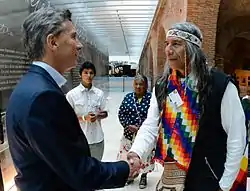| Total population | |
|---|---|
| Approximately 18 million | |
| Regions with significant populations | |
| 5.9 million (2017)[1] | |
| 4.1 million (2012)[2] | |
| 2.4 million(2017)[3] | |
| 1.9 million (2018)[4] | |
| 1 million (2010)[5] | |
| 955,032 (2010)[6] | |
| 817,963 (2010)[7] | |
| 724,592 (2011)[8] | |
| 117,150 (2012)[9] | |
| 78,492 (2012)[10] | |
| ~100[11] | |
| 20,344 (2012)[12] | |
| ~19,000[13] | |
| Languages | |
| Indigenous languages of the Americas, Quechua, Aymara, Guarani, Mapuche | |
| Religion | |
| Related ethnic groups | |
| Indigenous people of the Americas | |


The Indigenous peoples of South America or South American Indigenous peoples, are the pre-Columbian peoples of South America and their descendants. These peoples contrast with South Americans of European ancestry and those of African descent.
In Spanish, Indigenous people are often referred to as indígenas or pueblos indígenas (lit. Indigenous peoples). They may also be called pueblos nativos or nativos (lit. Native peoples). The term aborigen (lit. aborigine) is used in Argentina and pueblos aborígenes (lit. aboriginal peoples) is commonly used in Colombia. The English term "Amerindian" (short for "Indians of the Americas") is often used in the Guianas. Latin Americans of mixed European and Indigenous descent are usually referred to as mestizos (Spanish) and mestiços (Portuguese), while those of mixed African and Indigenous ancestry are referred to as zambos.
It is believed that the first human populations of South America either arrived from Asia into North America via the Bering Land Bridge and migrated southwards or alternatively from Polynesia across the Pacific.[14][15][16] The earliest generally accepted archaeological evidence for human habitation in South America dates to 14,000 years ago, the Monte Verde site in Southern Chile.[17] The descendants of these first inhabitants would become the indigenous populations of South America.
Before the Spanish colonization of the Americas, many of the indigenous peoples of South America were hunter-gatherers and indeed many still are, especially in the Amazonian area. Others, especially the Andean cultures, practised sophisticated agriculture, utilized advanced irrigation and kept domesticated livestock, such as llamas and alpacas.[18][19][20]
In the present day, there are two South American countries where indigenous peoples constitute the largest ethnic group. These are Peru, where 45% are indigenous and Bolivia, where 62% of people identify as feeling a part of some indigenous group.[21][22]
South American indigenous peoples include:
- Indigenous peoples in Argentina
- Indigenous peoples in Bolivia
- Indigenous peoples in Brazil
- Indigenous peoples in Chile
- Indigenous peoples in Colombia
- Indigenous peoples in Ecuador
- Indigenous peoples in French Guiana
- Indigenous peoples in Guyana
- Indigenous peoples in Paraguay
- Indigenous peoples in Peru
- Indigenous peoples in Suriname
- Indigenous peoples in Uruguay
- Indigenous peoples in Venezuela
See also
References
- ↑ "Perú: Perfil Sociodemográfico" (PDF) (in Spanish). Instituto Nacional de Estadística e Informática. p. 214. Retrieved 2021-04-30.
- ↑ "Características de la Población – Censo 2012" (PDF) (in Spanish). Instituto Nacional de Estadística. p. 103. Retrieved 2021-04-30.
- ↑ "Síntesis de Resultados Censo 2017" (PDF) (in Spanish). Instituto Nacional de Estadísticas. p. 16. Retrieved 2021-04-30.
- ↑ "Población Indígena de Colombia" (PDF) (in Spanish). Departamento Administrativo Nacional de Estadística. Retrieved 2021-05-01.
- ↑ "Informe Nacional del Ecuador" (PDF) (in Spanish). Ministerio de Desarrollo Urbano y Vivienda. p. 16. Retrieved 2021-04-29.
- ↑ "Censo Nacional de Población Hogares y Viviendas 2010" (PDF) (in Spanish). Instituto Nacional de Estadística y Censos. p. 281. Retrieved 2021-05-02.
- ↑ "População residente, segundo a situação do domicílio e condição de indígena". Instituto Brasileiro de Geografia e Estatística. Retrieved 2021-05-02.
- ↑ "Resultados Población Indígena" (PDF) (in Spanish). Instituto Nacional de Estadística. Archived from the original (PDF) on 2018-11-23. Retrieved 2021-05-01.
- ↑ "Tierra y territorio, fundamentos de vida de los pueblos indígenas, 2012" (PDF) (in Spanish). Dirección General de Estadística, Encuestas y Censos. p. 20. Retrieved 2021-04-30.
- ↑ "Final 2012 Census Compendium 2" (PDF). Bureau of Statistics. p. 5. Archived from the original (PDF) on 2021-01-05. Retrieved 2021-05-02.
- ↑ "Población por sexo y principal ascendencia étnico racial, según departamento" (XLS). Instituto Nacional de Estadística. Retrieved 2021-05-02.
- ↑ "Demografische en Sociale Karakteristieken en Migratie" (PDF) (in Dutch). Algemeen Bureau voor de Statistiek. p. 46. Retrieved 2021-05-02.
- ↑ Aupetit, Mathilde. "Les populations indigènes de la Guyane française : une mémoire environnementale essentielle à protéger" (in French). Retrieved 2021-05-03.
- ↑ "Study confirms Bering land bridge flooded later than previously believed". cyberwest.com. Retrieved 2017-02-22.
- ↑ Gongora, J.; et al. (Jul 28, 2008). "Indo-European and Asian origins for Chilean and Pacific chickens revealed by mtDNA". Proceedings of the National Academy of Sciences. 105 (30): 10308–10313. doi:10.1073/pnas.0801991105. ISSN 0027-8424. PMC 2492461. PMID 18663216.
- ↑ "Journal of the Polynesian Society: Notes And Queries, P 255-258". www.jps.auckland.ac.nz. Archived from the original on 2017-05-20. Retrieved 2017-02-22.
- ↑ Hey, Jody (2005-05-24). "On the Number of New World Founders: A Population Genetic Portrait of the Peopling of the Americas". PLOS Biology. 3 (6): e193. doi:10.1371/journal.pbio.0030193. ISSN 1545-7885. PMC 1131883. PMID 15898833.
- ↑ Earls, John. "The Character of Inca and Andean Agriculture" (PDF). Archived from the original (PDF) on 17 May 2017. Retrieved 22 February 2017.
- ↑ "4.1 Raised beds and waru waru cultivation". www.oas.org. Retrieved 2017-02-22.
- ↑ Pinedo, Javier Blossiers. "AGRICULTURA DE LADERAS A TRAVÉS DE ANDENES, PERÚ" (PDF). Archived from the original on 14 December 2010. Retrieved 22 February 2017.
{{cite web}}: CS1 maint: bot: original URL status unknown (link) - ↑ "The World Factbook — Central Intelligence Agency". www.cia.gov. Retrieved 2017-02-24.
- ↑ "The World Factbook — Central Intelligence Agency". www.cia.gov. Retrieved 2017-02-24.
.svg.png.webp)